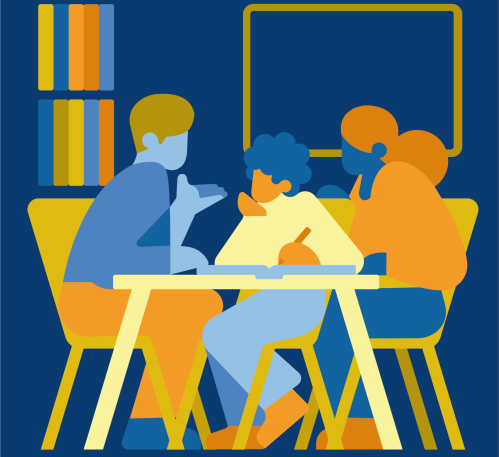The following essay comes from “Meaningful education in times of uncertainty,” a collection of essays from the Center for Universal Education and top thought leaders in the fields of learning, innovation, and technology.
 Web literacy must become a fundamental part of our global education system. Without it, opportunity is squandered. With it, we can propel billions farther, faster.
Web literacy must become a fundamental part of our global education system. Without it, opportunity is squandered. With it, we can propel billions farther, faster.
When Gauthamraj Elango teaches digital skills to youth in rural India, he takes an abstract approach. There are no rote typing exercises in his classes, nor are there intimidating code editors.
Gauthamraj is the co-founder of F-infotech, a Perundurai, India-based social enterprise that teaches individuals of all ages how to unlock opportunity online. When he’s in rural classrooms—where some students have never seen a computer—he finds that teaching the general concepts of the web, rather than specific hardware and software, is most effective.
Through offline, hands-on activities and roundtable discussions, Gauthamraj and students unpack what a URL is, how browsers are used, and the diverse opportunities an internet connection can unlock. His students aren’t simply learning a trade; they’re gleaning a fundamental understanding of how the web works.
In a world where the number of internet users is growing at breakneck speeds—and where the internet increasingly shapes all aspects of society—understanding the web is essential for nearly everyone. The internet is the world’s newest, most vital, public resource. It continues to expand exponentially. Now, three billion people are online, and new infrastructure and cheap hardware mean billions more will join in the coming years. Internet speeds are accelerating swiftly. And the Internet of Things is connecting the internet to homes, cars, and the infrastructure of cities.
Unlocking internet’s potential requires web literacy
For students like Gauthamraj’s, who may not be online for another couple of years, the fundamentals of online life are essential. Without a strong grasp of web literacy, individuals and institutions will miss the internet’s potential, and cannot harness the web for learning. They cannot, as Sam Dyson, Director of Mozilla’s Hive Chicago Learning Network, has observed, “use the internet to solve shared problems of practice or life.” The internet becomes smaller, scarier, less wonderful.
The problem, both in regions with a pedigree of access (e.g. U.S.) and in regions that are connecting for the first time (e.g. India or Kenya), is that web literacy is largely absent from classrooms. And where it does exist, it remains inadequate.
An adequate education in web literacy would provide a framework for understanding the internet. It’s not just about learning to type or to use a computer or smartphone, nor is it about mastering a programming language like JavaScript. It’s about the gulf in between. Web literacy requires understanding the difference between a web browser, a search engine, or an app, and being able to leverage each. It’s about knowing how to evaluate online content, and knowing how to differentiate between the credible and the dishonest. It’s about the ability to thwart phishing attempts, to craft strong passwords, and to control how personal data is collected and used.
In the developed world, access has been a matter of public policy for decades. Individuals who now hold computers in the palms of their hands began their relationship with the internet years ago, seated in front of a desktop. The result is an assumed, or natural, familiarity with the mechanics of the web. Navigating an operating system (OS), a website or a social network is often expressed as second nature. Skills are mostly acquired informally and therefore lack a firm educational underpinning.
Consider Victor, a high school student, swiping through an app store and selecting new software to download. The process is a breeze. But does Victor understand the models that make this software “free”? Does he understand that he pays for it with personal data, collected surreptitiously? Nope. His mastery of the app store remains superficial.
In 2015, Mozilla conducted web literacy research in Chicago to better understand how individuals engage with the web. The study revealed that applications like SnapChat can amplify some of the web’s best qualities, like free expression and instant connection. “Snapchat has lowered the bar for content creation,” researchers observed. “It is a new form of ephemeral and ongoing conversation, allowing youth to maintain constant connection with their friends.” But users barely even recognize that they are subject to SnapChat’s rules and limitations.
Teenagers use social networking apps almost exclusively, and therefore, they don’t know that they are missing out on the wider web’s breadth. There are no thickets of hyperlinks, no galaxies of websites, no freedoms to hack and customize, no opportunities to learn snippets of HTML and CSS. That is because the skills they would need to take advantage of the web—to move beyond the borders of familiar apps—remain largely absent from traditional classroom settings. “Few activities cover subjects that matter to teenagers, like YouTube or Snapchat,” researchers note. “As a result, few activities encourage students to think critically about the tools they use.”
Worse still, what little web literacy curriculum does exist can sometimes provoke fear and anxiety. “Most digital citizenship learning environments focus on the dangers of the web,” researchers report. “While these are important, they do not cover the positive aspects of being a web citizen. Teenagers learn about security, but they do not grasp the bigger global web, trapping them inside the ‘Instagram bubble.’”
For first-time internet users in the global south—where internet access has historically been scarce—barriers to access are now crumbling. Cheap smartphones and evolving telecom infrastructure connect more and more people. From Nairobi to Kolkata to Jakarta, billions more people are discovering the web. Access is essential—but it is only an entry point. It needs to be coupled with sustained adequate education in web literacy. Otherwise, the consequences are dire.
Mozilla recently concluded a 12-month research project exploring this issue. With support from the Bill & Melinda Gates Foundation, we constructed a Digital Skills Observatory (DSO) spanning seven Kenyan cities. It assessed how low-income, first-time smartphone users experience the web, unpacking the relationship between digital skills, social structures, and economic factors. Not surprisingly, we discovered that internet access without web literacy can worsen existing economic and social woes.
For example, our researchers met Evans in Nairobi. Lacking steady employment, Evans seeks small jobs each day, often putting his earnings toward online betting. This habit has garnered him a television and sound system, but also outstanding debts to digital financial service providers like M-Shwari. Evans doesn’t worry. He believes the companies that lend him money are well-off enough to shrug off his debts. Without a grasp of digital financial services, access has exacerbated his debt and deepened his gambling problems.
Then there’s Esther, a Mombasa water seller. Esther inquired about an app she discovered on the Play Store—it purported to diagnose HIV. The app randomly displayed a diagnosis after “scanning” a user’s fingerprint. It’s a foul prank—and for someone without web literacy training, frighteningly convincing. Without a grasp of digital media, access opened Esther up to scams, frauds, and misinformation.
Real-world stories like these were common throughout the DSO research. Individuals engage with small sections of the internet and experiencing its nadir. The newly connected, without web literacy training, find a web that’s closed, centralized, commercialized, and confounding. It is dominated by just a few entities like Google, Facebook, and Safaricom, who control access to apps and communication channels. Moreover, it is broadcast, rather than participatory in nature—content is consumed, rather than created, preventing new digital citizens from shaping the web with their own languages and ideas.
The stories of Victor, Esther, and Evans all paint a dismal picture of our ability to teach vital digital skills. But Mozilla’s research, and research by the broader network of NGOs and educators working toward universal web literacy, has also uncovered bright spots.
Building towards fluid digital comprehension
There has been impressive progress mapping the fundamentals of web literacy. Mozilla crafted the Web Literacy Map, an interactive framework for 21st century skills. The map parses digital skills into three categories: Read (searching, synthesizing, and evaluating content online); Write (designing, coding and remixing content online); and Participate (understanding privacy and security basics).
Cultivating these fundamental skills will help move a learner from basic building block techniques to fluid comprehension. Built on traditional literacy principles, it goes from the reader to the word, to the word to the world, and eventually, the reader to the world. The map is grounded in prior research like the American Library Association’s 2011 (ALA) Digital Literacy definition, the International Society for Technology in Education (ISTE) 2016 Standards for Students and the United Nations Educational, Scientific and Cultural Organization’s 2013 Global Media and Information Literacy (UNESCO MIL) Framework.
Educators, both formal and informal, are also at work crafting inquiry-centric web literacy curricula, in the form of open-source and hands-on activities. Educators swap and remix activities like HTML Puzzle Boxes (created in Indonesia, and useful for teaching HTML basics), Web Chef (for teaching the principle of remixing online) and Thimble (for understanding the building blocks of code). As open-source creations, the same people who use them every day build these tools. For example, more than 300 contributors from dozens of countries built Thimble, which has also been localized into 33 languages.
Furthermore, initiatives like Open Badges provide a way for learners to document their web literacy achievements and competencies. Badges exist in a trustworthy and open-source ecosystem, allowing anyone with an internet connection to showcase their skills. Thousands of organizations—from NASA and the NYC Department of Education to Peer to Peer University and Universidade Federal de Goiás—are active in the Open Badges ecosystem, which is stewarded by IMS Global Learning Consortium, LRNG, and Mozilla.
Another bright spot is the potential for informal and extracurricular educational activities to teach web literacy. Libraries, community centers, independent mentors, organizations, and individuals all have the potential to help develop people’s critical digital skills. In Chicago, we interviewed Linda, who runs an afterschool program that teaches youngsters how to blog; we met George, who runs workshops that deploy Makey Makey kits (hackable circuit boards) and Scratch (MIT Media Lab’s tool for creating online); and we spoke with James, a teacher who covers robotics, game design and general online life in his after-school program.
Chicago is also home to Hive Chicago, an award-winning, peer-learning network with a focus on youth-serving organizations. Local libraries and universities seek new ways to teach web literacy through interest-driven, hands-on sessions digital workshops; targeted grants program; and the collaborative production of beta tools and applications.
In Kenya, we witnessed innovative and successful methods for teaching web literacy, like in-person community workshops led by local experts, and chatbots. These workshops and tools are built on trust, empathy, and local expertise, and impart essential skills like managing data usage, recognizing scams, resetting passwords and managing browser settings.
Organizations like U.N. Women are investing in this approach, training and empowering local educators and technologists who can serve as catalysts for web literacy. Local teaching capacity can be grown and developed exponentially.
These solutions aren’t simple to implement or scale. But universal web literacy is an ambitious vision—so we need ambitious solutions. We need to invest in, and grow, the movement to teach web literacy. The more we recognize web literacy as the fourth “R,” the sooner we can move billions farther, faster. And while web literacy is not the silver bullet for 21st century learning at scale, without it, the chances of attaining equity in learning are certainly out of reach.





Commentary
Op-edWe’re not teaching the web correctly
August 3, 2017